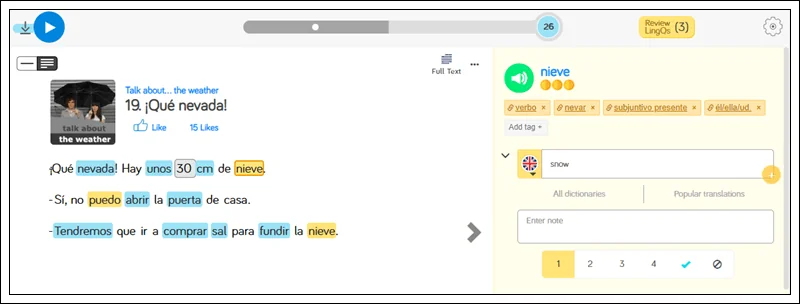Our Guide to Spanish Numbers
One of the first things you know in a language, even as a child learning your mother tongue, is how to count. Numbers are the basis of a variety of different ways to communicate. If you just opted to learn Spanish, that information doesn’t change—you should still start with the numbers.
They are important even if you are going around in the city. You need to understand and learn how to talk about prices, about road numbers, how many minutes, how many orders do you want, etc.
However, learning numbers in Spanish doesn’t have to be a big overwhelming task. I have put this guide together to help you through the basics of learning numbers in Spanish, or rather, los numeros en español.
Instead of just learning all the numbers and memorizing them one by one, look for patterns in counting, just as there is in English.
This guide will help you understand the patterns better, take a look 🙂
Recognizing Patterns
First, learn all the numbers, from one to fifteen:
1: uno
2: dos
3: tres
4: cuatro
5: cinco
6: seis
7: siete
8: ocho
9: nueve
10: diez
11: once
12: doce
13: trece
14: catorce
15: quince
Once you have these down, move on to the numbers that are multiples of ten. Simple enough to remember, except for twenty, which is “veinte”, they all end in –enta. They are also, all except “veinte” again, related to the numbers one through ten to their corresponding sequence:
20: veinte
30: treinta
40: cuarenta
50: cincuenta
60: sesenta
70: setenta
80: ochenta
90: noventa
From sixteen onward, all you have to do is combine the numbers with a “y” (pronounced “e”) in the middle, and you’ve done it.
For example, from 16-19, it is ten and six, ten and seven, ten and eight, and finally, ten and nine. In Spanish, these will be pronounced:
16: “diez + y + seis”: dieciséis
17: “diez + y + siete”: diecisiete
18: “diez + y + ocho”: dieciocho
19: “diez + y + nueve”: diecinueve
Moving forward, when talking about the “tens” numbers, you also just combine the multiples of ten words we just learned than combine them with the “ones” numbers, adding the “y”.
(pronounced “e”) again in the middle. In Spanish, these will be pronounced:
31: treinta y uno
41: cuarenta y dos
51: cincuenta y tres
“Veinte” is the only exception in the fact that it takes off the ending of the word, adds an “i” and smashes it all together.
For example:
“veinte + y + uno”: veintiuno
“veinte + y + dos”: veintidós
Now that you have 1-99, all you need to add is the numbers zero and one hundred.
In Spanish, they are:
0: cero
100: cien
Now you have the basics of zero to one hundred.
Hundreds of Spanish Numbers
If you want to move on to larger numbers over one hundred, the concepts stay the same, it’s just the numbers that come before are different. For example, if you were to say 101, you would combine what you just learned and add it after “ciento”.
For example:
101: ciento uno
125: ciento veinticinco
163: ciento sesenta y tres.
Note that you are not adding a “y” in between one hundred and the one or the twenty-five. You say it fluidly.
Since we’re working on the hundreds, I might as well introduce you to the other counts of one hundred. They are basically the original number with “cientos” added to it, with the exception of 500, 700, and 900. Here are the hundreds in Spanish:
200: doscientos
300: trescientos
400: cuatrocientos
500: quinientos
600: seiscientos
700: setecientos
800: ochocientos
900: novecientos
Now you have the basics. You can work with all the numbers up to one thousand, which is “mil”, by the way.
One Thousand and More
With “one thousand”, you have to remember that you don’t use “un mil”, opposed to when you talk about “one million”, where you use “un millón”.
Here are a few examples of bigger numbers:
1,000: mil
20,000: veinte mil
100,000: cien mil
1,000,000: un millón
3,000,000: tres millones
Last but not least, what sets Spanish apart from numbers in English is the way they are written down. In a math class in Honduras, you might be a little confused as to why there are decimal points or commas in places where you normally wouldn’t see them.
Decimals and Commas
In English, you normally use commas to break up several thousands or millions. For example, instead of “4352873”, you would write: “4,352,873”.
Also in English, you would normally use decimal points to break up partial numbers. For example, you would write: “1.33”
In Spanish, however, it’s quite literally the opposite. You use decimal points to break up large numbers. For example, instead of “4,352,873”, you would write: “4.352.873”.
Some countries even use spaces instead of where we use commas. So it would be: “4 352 873”.
In Spanish, when breaking up partial numbers, you use commas. So, our English “1.33” becomes “1,33”. Which you’ll probably see a lot of it you are shopping and looking at prices.
Just for fun, if you ever do talk about large numbers in Spanish, here are the big guys:
un millón = one million = 1,000,000
un millardo (or “mil millones”) = one billion = 1,000,000,000
un billón = one trillion = 1,000,000,000,000
mil billones = one quadrillion = 1,000,000,000,000,000
un trillón = one quintillion = 1,000,000,000,000,000,000
Spanish numbers in context
If you want go a step further while studying Spanish, check out LingQ!
LingQ lets you learn from content you love, which is one of the best ways to learn Spanish! Whether you enjoy watching Spanish Youtubers, listening to podcasts, or reading blogs, you can import a variety of online content and create interactive lessons to help you study.
LingQ also comes with 1000s of hours of beginner content to help you get started.

Not only that, LingQ is available for iOS and Android, allowing you to take your lessons on the go!
If you want an easier and more enjoyable way to learn Spanish, give LingQ a try today. Grow your vocabulary, interact with a community of learners, ask for tips, and find an infinite amount of content to learn from.
How long does it take to learn Spanish? Check out polyglot and LingQ cofounder Steve Kaufmann’s blog post to learn about the 5 factors that influence this!
***
Adriana Rodrigues is a Peruvian-American who has had experience playing professional soccer and working while speaking Spanish In addition to Spanish, she knows German, Portuguese, and English.


